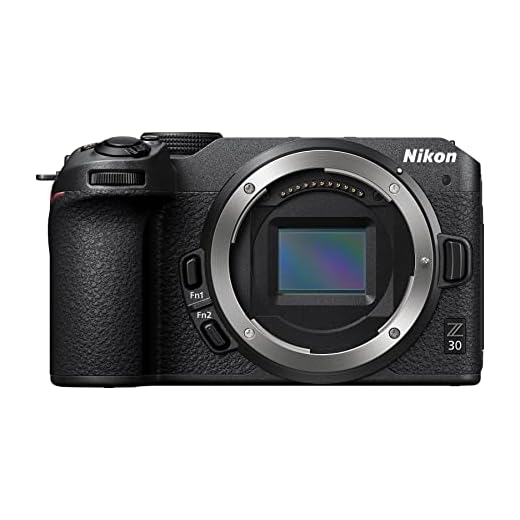Nikon Z50 vs Z30
When it comes to choosing a mirrorless camera, Nikon offers a variety of options, including the Nikon Z30 and Nikon Z50. Both cameras cater to different types of users, but they also share several features that make them strong contenders in the market. This detailed comparison of Nikon Z50 vs Z30 will help you understand the key differences and similarities between these two models, enabling you to make an informed decision based on your photography needs.
Comparison Table – Nikon Z50 vs Z30
| Feature | Nikon Z30 | Nikon Z50 |
|---|---|---|
| type | Mirrorless | Mirrorless |
| viewfinder | ✖ | ✔ |
| is weather-sealed (splashproof) | ✔ | ✔ |
| screen resolution | 1040k dots | 1040k dots |
| evf resolution | ✖ | 32k dots |
| has a built-in focus motor | ✖ | ✖ |
| has a flip-out screen | ✔ | ✔ |
| viewfinder coverage | ✖ | 100% |
| screen size | 3″ | 3.2″ |
| weight | 405 g | 395 g |
| has a touch screen | ✔ | ✔ |
| has a hot shoe | ✔ | ✔ |
| volume | 559.78 cm³ | 709.66 cm³ |
| is a system camera | ✔ | ✔ |
| has a flash | ✖ | ✔ |
| lowest potential operating temperature | 0 °C | 0 °C |
| maximum operating temperature | 40 °C | 40 °C |
| has a tilting viewfinder | ✖ | ✖ |
| evf refresh rate (max) | ✖ | ✖ |
| waterproof depth rating | ✖ | ✖ |
| lens hood is reversible | ✖ | ✖ |
| width | 128 mm | 126.5 mm |
| height | 73.5 mm | 93.5 mm |
| thickness | 59.5 mm | 60 mm |
| sensor size | APS-C | APS-C |
| lens mount | Nikon Z | Nikon Z |
| focus points | 209 | 209 |
| megapixels (main camera) | 20.9 MP | 20.9 MP |
| maximum iso | 51200 ISO | 51200 ISO |
| maximum expanded iso | 204800 ISO | 204800 ISO |
| has sensor shift stabilization | ✖ | ✖ |
| continuous shooting (mechanical) | 11 fps | 11 fps |
| has af tracking | ✔ | ✔ |
| has phase-detection autofocus for photos | ✔ | ✔ |
| fastest shutter speed | 1/4000 s | 1/4000 s |
| has manual focus | ✔ | ✔ |
| has touch autofocus | ✔ | ✔ |
| has manual shutter speed | ✔ | ✔ |
| has a built-in hdr mode | ✖ | ✔ |
| has a bsi sensor | ✖ | ✔ |
| has manual exposure | ✔ | ✔ |
| has a two-stage shutter | ✔ | ✔ |
| has a serial shot mode | ✔ | ✔ |
| has a cmos sensor | ✔ | ✔ |
| has manual iso | ✔ | ✔ |
| flash sync speed | 1/200 s | 1/200 s |
| has manual white balance | ✔ | ✔ |
| can create panoramas in-camera | ✖ | ✖ |
| exposure time | 30 s | 30 s |
| maximum electronic shutter speed | ✖ | ✖ |
| shutter lag | ✖ | ✖ |
| expeed version | 6 | 6 |
| digic version | ✖ | ✖ |
| has a stacked cmos sensor | ✖ | ✖ |
| cross-type focus points | ✖ | ✖ |
| power-on delay | ✖ | ✖ |
| pixel size (main camera) | ✖ | ✖ |
| can combine image stabilization | ✖ | ✖ |
| video recording (main camera) | 2160 x 30 fps | 2160 x 30 fps |
| has phase-detection autofocus for videos | ✖ | ✔ |
| has continuous autofocus when recording movies | ✔ | ✔ |
| has a microphone input | ✔ | ✔ |
| has a socket for a 3.5 mm audio jack | ✖ | ✖ |
| has a stereo microphone | ✔ | ✔ |
| has timelapse function | ✔ | ✔ |
| movie bitrate | ✖ | 144 Mbps |
| number of microphones | 2 | 2 |
| has a 24p cinema mode | ✔ | ✔ |
| supports slow-motion video recording | ✔ | ✔ |
| battery life (cipa) | 330 shots | 300 shots |
| has a removable battery | ✔ | ✔ |
| has a rechargeable battery | ✔ | ✔ |
| has a battery level indicator | ✔ | ✔ |
| battery power | 1120 mAh | 1120 mAh |
| supports wi-fi | ✔ | ✔ |
| has bluetooth | ✔ | ✔ |
| has dual card slots | ✔ | ✖ |
| has pixel shift shot | ✖ | ✖ |
| shoots raw | ✔ | ✔ |
| supports lossless compressed raw | ✔ | ✖ |
| wi-fi version | Wi-Fi 5 (802.11ac), Wi-Fi 4 (802.11n) | Wi-Fi 5 (802.11ac), Wi-Fi 4 (802.11n) |
| supports a remote smartphone | ✔ | ✔ |
| has an hdmi output | ✔ | ✔ |
| has gps | ✖ | ✖ |
| has first-party support for live streaming | ✔ | ✖ |
| has an advanced hot shoe | ✔ | ✖ |
| dxomark sensor score | ✖ | ✖ |
| dxomark sports score | ✖ | ✖ |
| dxomark landscape score | ✖ | ✖ |
| dxomark portrait score | ✖ | ✖ |
| usb version | ✖ | 2 |
| hdmi version | ✖ | ✖ |
| has nfc | ✖ | ✖ |
| has an external memory slot | ✖ | ✔ |
| internal storage | ✖ | ✖ |
| has usb type-c | ✔ | ✖ |
| bluetooth version | 4.2 | 4.2 |
Design and Build Quality
The Nikon Z30 and Z50 are both mirrorless cameras, ensuring a compact and lightweight design. The Z30 weighs slightly more at 405 grams compared to the Z50’s 395 grams. Both cameras are weather-sealed, offering protection against dust, raindrops, and water splashes, which is crucial for photographers who shoot in various environments.
While the Z50 features an electronic viewfinder (EVF) with a resolution of 32k dots, the Z30 lacks an EVF, which might be a deciding factor for those who prefer composing their shots through a viewfinder rather than the LCD screen. Both models have a screen resolution of 1040k dots, ensuring clear and sharp image previews.
Display and Usability
Both cameras come with a flip-out touchscreen, making it easier to shoot from tricky angles. The Z30 has a 3-inch screen, while the Z50 boasts a slightly larger 3.2-inch screen. This difference, though minor, can enhance the user experience when reviewing images or navigating through the menu.
Another point of consideration is the hot shoe feature present in both models, allowing users to attach external flashes or other accessories. However, the Z50 also includes a built-in flash, which the Z30 lacks, making the Z50 more versatile in low-light conditions.
Performance and Features
In terms of optics, both the Nikon Z30 and Z50 use an APS-C sensor with a resolution of 20.9 megapixels, ensuring high-quality images. They share the same maximum ISO of 51200, expandable to 204800, making them capable of handling various lighting conditions. Both models support continuous shooting at 11 frames per second, ideal for capturing fast-moving subjects.
The Z50 has a slight edge with its built-in HDR mode and BSI sensor, which enhances low-light performance and overall image quality. Both cameras offer manual exposure, manual ISO, and manual shutter speed options, catering to advanced users who prefer to have full control over their settings.
Videography Capabilities
For videographers, both cameras can record in 4K at 30 fps. The Z50, however, has an advantage with phase-detection autofocus for videos, ensuring sharper and more accurate focusing during recording. Both models support continuous autofocus when recording movies, making them suitable for capturing dynamic scenes.
While both cameras have a microphone input, they lack a 3.5 mm audio jack, which might be a limitation for those looking to use standard headphones. They do, however, include stereo microphones and a timelapse function, expanding their video recording capabilities.
Battery Life and Connectivity
Battery life is another critical factor. The Z30 can take approximately 330 shots per charge, slightly more than the Z50’s 300 shots. Both cameras feature a removable, rechargeable battery with a capacity of 1120 mAh. Additionally, they have Wi-Fi and Bluetooth capabilities, allowing for easy file transfers and remote control via a smartphone.
The Z50 includes an external memory slot, which the Z30 lacks, providing more flexibility for storage options. Both models support dual card slots, ensuring you have ample storage for your photos and videos.
Final Verdict
Choosing between the Nikon Z30 and Z50 depends on your specific needs. If you prioritize having an EVF, built-in flash, and slightly better video autofocus, the Z50 is the better choice. However, if you prefer a lighter camera with similar core features and a slightly better battery life, the Z30 is an excellent option.
Also See:
Nikon Z6 II vs Nikon Z5 – Comprehensive Comparison
Apple Unveils macOS 15 Sequoia at WWDC 2024
Meta Unveils Revolutionary AI “Segment Anything Model”
——————————————————————————————————————————————
Techcazt, Tech Magazine. We provide you with the latest news, reviews, and insights on the most cutting-edge technology available today. Whether you’re a hardcore gamer, a tech enthusiast, or just looking for great deals on your favorite gadgets, we’ve got you covered. The articles published in our magazine are intended to provide general information and ideas related to Tech and related topics. We strive to provide accurate and up-to-date information, but readers should always conduct their own research and consult with professionals before making decisions. If you have any comments or suggestions, please comment below. You can also follow us on Facebook, Instagram, and Twitter. Do not forget to give us a LIKE and SUBSCRIBE.





